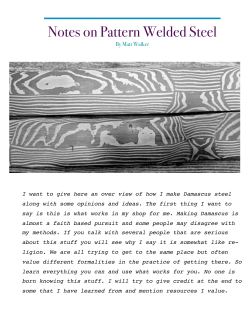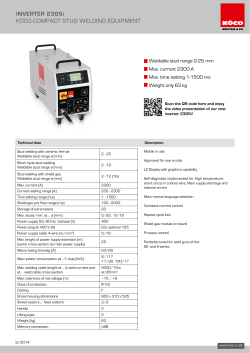
Orbital Welding Equipment Used in the Application: Material:
Automated Orbital Welding with Arc Machines, Inc. Orbital Welding Equipment Used in the Fabrication of Chemical Tanker Ships Application: Chemical tankers piping system Material: Type 316L stainless steel Welding Equipment: Power Supply: Model 227 Weld Heads: Model 15 Model 95 Model 9 series Benefits: Consistent, high-quality weld-after-weld Superior productivity 60% savings vs. manual welding 125-130 welds/day using 2 weld heads 8,000 welds with only 0.025 % (2) failures For further information, call AMI at 1-818-896-9556 or e-mail sales@arcmachines.com Model 227 Model 15 Model 95 When Juliana Constructora Gijonesa, a shipbuilder in Spain was contracted to build 7 chemical tankers featuring tanks and pipes of stainless steel, they decided to upgrade their welding processes and procedures to increase efficiency. The welders used orbital GTAW for as much as 90% of the piping, which resulted in a documented steady increase in productivity. Using automated orbital welding required only 1 shift per day vs. 2 shifts with manual welding. Also, the change from pipe end-preparations for manual welding to orbital welding saved up to 60% of the welding time. Juliana purchased three Model 227 microprocessor-controlled power supplies with heads-up display and water cooling unit from Arc Machines, Inc. In addition to the power supplies, Juliana purchased 3 types of orbital weld heads, the Model 15 with external wire feeder, which can oscillate the torch across the weld seam to produce a weave bead and has automatic voltage control (AVC) to maintain a constant arc gap; the Model 95 that features a mechanical arc gap controller; and the Model 9 series fusion weld heads to weld small diameter stainless steel sleeves. Welders used the Model 9AF-900 fusion weld heads to weld 10-18 mm diameter Type 316L stainless steel tube with a heavy sleeve. For the first ship, Juliana did 5,000 small sleeve welds orbitally out of a total of 8,000 welds. For the second ship, welders did 5,000 orbital welds in the workshop and 3,000 on board ship to weld tubes to valves. The welders finished 125-130 orbital sleeve welds per day using two heads. Of the 8,000 welds there were only 2 failures after the hydraulic test, a reject rate of only 0.025%. Orbital welding allows the development and testing of weld procedures which, once done successfully, can be repeated from weld-to-weld indefinitely. A visual inspection required by law was performed on 5 percent of the ID of the production welds. When viewing the radiographs of the orbital welds, they were so consistent that the inspector had to be convinced that the X-rays were indeed from different welds. To read the full story, visit www.arcmachines.com QUICK SPECS M227 Power Supply Input Power Weld Current Memory Capacity I/O Device 100 - 240 VAC service single-phase 50/60 Hz 3 - 100 A DC @ 100/120 VAC input 3 - 225 A DC @ 200/240 VAC input 100% Duty Cycle 100 weld schedules maximum, M-227EMM 100 levels per schedule maximum, 100 different passes per level Water Cooler Dimensions Weight Optional 15” x 23” x 20” (381 mm x 584 mm x 508 mm) 88 lbs. (40 kg) M15 Weld Head AVC Stroke Torch Oscillation Stroke Wire Feed Speed 1.75” (44,45 mm) 2” (50,8 mm) 5 to 200 IPM Radial Clearance Range Axial Clearance Range 3.69” (93,73 mm) (Minimum) depends on pipe diameter, torch type and configuration 11.5” (292,1 mm) (Minimum) depends on torch type and options Single or dual wire feeder options are available Several torch types are available Compatible with AMI Model 415 or Model 227 Power Supplies M95 Series Weld Heads OD Range Wall Thickness Torch Rotor RPM Head Weight 0.625” - 6.625” (16 mm - 170 mm) up to 0.3” or 0.44” (7,62 mm or 11,17 mm) 0.05 - 10 Water cooled, 200 A continuous Duty Cycle 5 lbs. - 16 lbs. (2 kg - 7 kg) Compatible with AMI M415, M227, M307 or M207 (fusion-only using optional adapter) Power Supplies. MKT-SH20 / January, 2011 / E
© Copyright 2025





















